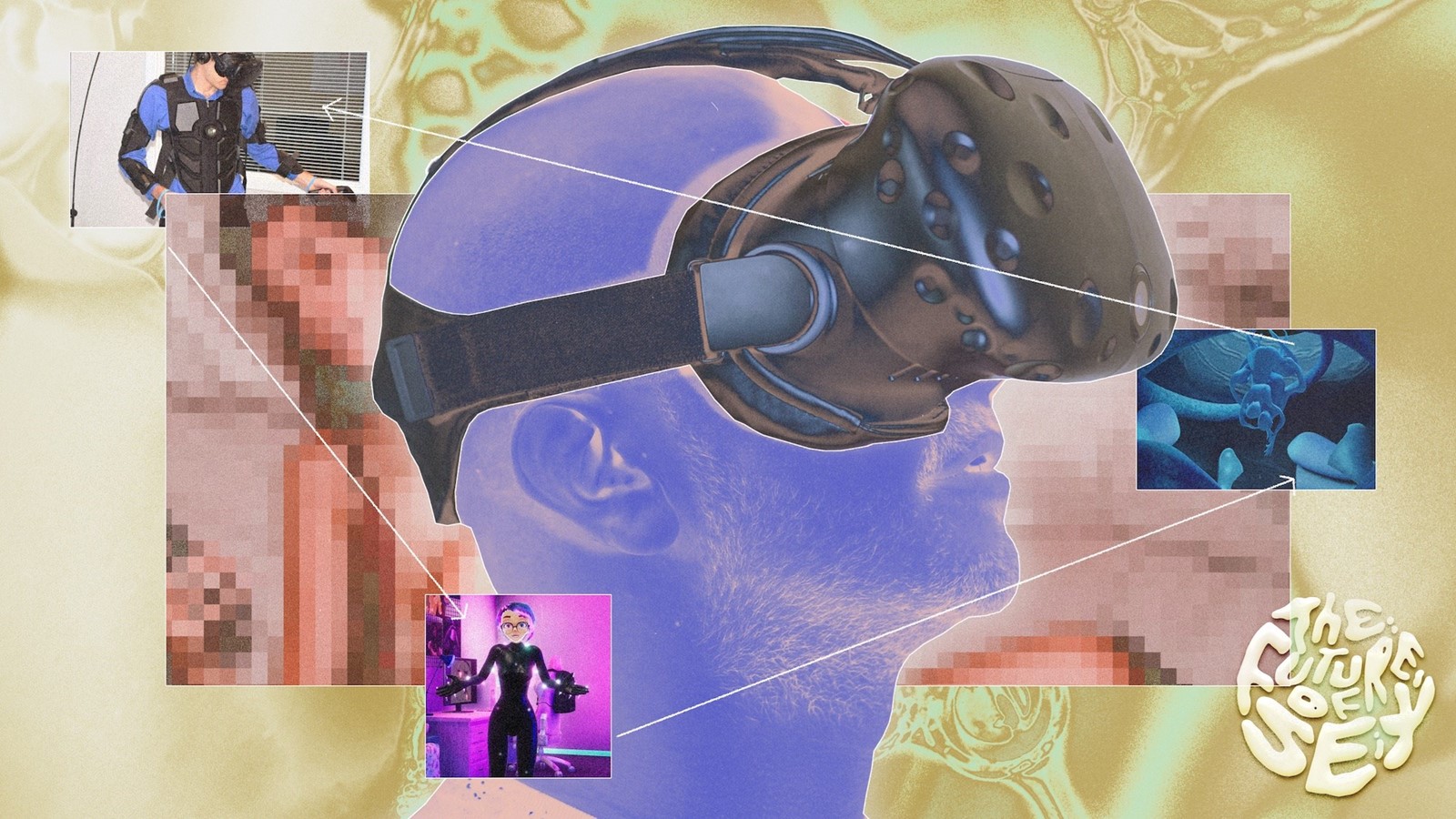Whether it’s VR dating apps or hook-up chatrooms on Discord, people across the world are donning sex tech and forging real relationships in virtual worlds
This article is part of our Future of Sex season – a series of features investigating the future of sex, relationships, dating, sex work and sex worker rights; tech; taboos; and the next socio-political sexual frontiers.
Less than an hour into VRChat and a catgirl is riding on the back of a centaur. She tugs on his horns playfully and the pair trot towards the neatest portal. They’re replaced by two furries in fetish gear who begin to hump each other aggressively – a bizarre, if not unthinkable, chain of events. But, for anyone who’s ever stepped into the wild west of VRChat, it’s pretty standard.
As one of the only virtual reality applications that comes close to implementing anything resembling the futuristic vision of the metaverse, VRChat is perhaps the closest example we have to an online world where users can not only meet new people as embodied avatars, but enact their sexual fantasies. All the content in the game is user generated, which means anything goes – as long as you can build it in the unity game engine. And, while ERP (erotic roleplay) is strictly prohibited by moderators, this doesn’t apply to private rooms, where users can download genitalia-modded avatars, don haptic VR suits and sex tech to elicit real sexual encounters.
Finding real intimate connections through online games is nothing new. You only need to look at early examples on Second Life, where numerous reports of in-game affairs ended in real-life divorce. But, as our lives become increasingly digitised, the desire to form intimate connections in digital spaces is growing. In 2021, a study by the customer service platform Tidio found that 88 per cent of respondents believe it is possible to form meaningful relationships in a virtual space – a bridge we’ve already partially crossed with the popularity of dating apps.
Initially created for long-distance relationships, teledildonics, AKA high-tech sex toys, are being adopted by people who want to have sex in the metaverse. Companies such as Lovense or Inmi sell internet-connected vibrators and fleshlights that can be used to simulate (stimulate?) the deed. There’s even an entire hook-up culture organised around Discord servers, where users can find partners in much the same way as you would a dating app.
“Sophisticated gloves and vests, able to track movement and mimic our sense of touch, are about to be commercialised by different companies,” explains Dr Paula Gortázar, a lecturer at the University of Westminster who investigates the forms and uses of still photographs within extended reality environments. “It’s likely that corporeal accessories will get more complex and precise, with virtual sex devices offering physical experiences that might very well be more intense than real-life sexual interactions.”
While developments in sex tech are creating increasingly immersive cybersex experiences – many VR users also report experiencing phantom touch – there’s more to the metaverse than simply humping pixels. If you can get past the nauseating motion sickness, and having a four-pound brick strapped to your head (not to mention the steep price tag), meeting people in VR is no different to meeting them IRL. Wander down the rabbit hole and you’ll find a bewildering variety of public and private spaces to explore: beaches, restaurants and bars, dinosaur safaris, a 90s recreation reimagining of K-mart – you name it.
“Traditional dating apps don’t really work for 80 per cent of the population, because they’re all architected around pictures first, which focuses the entire experience on physical attraction before you can get to the deeper aspects of connection and compatibility”
Dubbed the metaverse Tinder, Nevermet is a VR dating app where users can swipe for matches using avatar-based profiles. Users are given the option of uploading a voice recording – an important feature in metaverse dating – while physical locations are replaced with digital platforms such as VRChat or Rec Room. Similarly, Flirtual gives users the opportunity to find people to go on dates in social VR apps, with the option of exchanging physical photos later on.
“We found that traditional dating apps don’t really work for 80 per cent of the population using them because they’re all architected around pictures first, which focuses the entire experience on physical attraction before opening a chat where you can get to the deeper aspects of connection and compatibility,” explain the creators of Nevermet. They describe creating a dating environment where you first connect with each other, before finding out what the other person looks like IRL. “You do this by connecting as avatars, which you can design in any way you represent yourself, and going on amazing, out-of-this-world dates in the metaverse together.”
These CG environments offer a space where people can free themselves from the expectations that society imposes on them, such as gender, race and physical appearance. “The ability to be lots of different avatars allows you to see different aspects of yourself. It gives you the freedom to be who you want to be,” affirm the Nevermet founders. “This can ultimately enable us to express ourselves more authentically and lead to deeper, more authentic, and more intimate relationships with our partners.”
For example, a recent HBO documentary, We Met in Virtual Reality, takes a glitches-and-all look at couples in disparate parts of the world who met on VRChat during the pandemic. One particular character, referred to simply as Toaster, has spent two years on mute, hanging out on countertops and silently pining after in-platform belly dancing instructor DustBunny. It’s a bizarre dynamic, but if anything, reveals the extent of sexual freedom on the platform.
In her 2020 book Glitch Feminism, Legacy Russell explores how online spaces and technology evade the body’s limits and society’s perceptions of it. “With physical movement often restricted, female-identifying people, queer people, Black people invent ways to create space through rupture,” she writes. “Glitch feminism gives weight to the selves we create through the material of the internet.”
The idea that we can express ourselves and safely explore our desires, unshackled by the identities we have to live with in real life, is an attractive proposition. VRChat has already proved a useful platform for trans people exploring their identities for the first time, disabled people who find freedom in the platform’s accessibility mods, and furries and otherkin who’ve been virtual dens for themselves and their kin.
While the prospect of forming relationships with a person solely on the basis of their personality sounds appealing, if not slightly unrealistic, there is a darker side to social VR apps. Sexual assault is already a problem. Earlier this year, a SumOfUs researcher experienced virtual gang rape in Horizon World – and reports suggest it will only get worse. In February, Meta introduced a “personal boundary” feature, which is designed to keep others from violating your avatar’s personal space, though this doesn’t protect against verbal assault or intimidation.
Similarly, the Center for Countering Digital Hate found last December that users, including minors, are exposed to abusive behaviour every seven minutes in VRChat, ranging from graphic sexual content to racist slurs. There clearly needs to be more safety features or moderation put in place to prevent this from happening. But stepping too far in the other direction risks sanitising the freewheeling chaos that made VRChat so popular.
As with any emerging technology, there’s a tendency to categorise VR as either categorically Good or Bad. And while the possibility of choosing an avatar and getting frisky with someone in the metaverse sounds like a fun idea, there’s a lot of progress that needs to be made to avoid downward spiralling into Black Mirror-level dystopia. Still, the metaverse holds unlimited possibilities for a future not tied down by real-world rules. So, plug in and get prepped, because it’s going to be a wild one.

